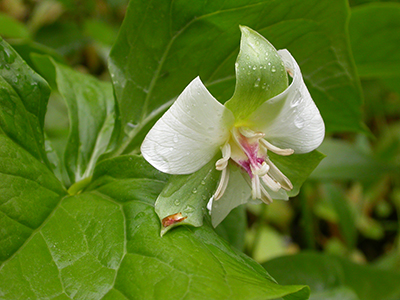Drooping Trillium

Photo: Colin Jones
Species information
This chapter provides a review of progress towards the protection and recovery of Drooping Trillium in Ontario from 2007 to 2017.
Drooping Trillium (Trillium flexipes) is a showy herbaceous perennial that is currently known at only two locations in southwestern Ontario. The sturdy, upright main stem grows to a height of 15 to 60 centimetres tall. Three broad, pointed leaves, which grow up to 20 centimetres in length, are arranged in a whorl at the top of the stem. A single flowering stalk, 3 to 12 centimetres long, grows in a downward arc from the junction of the three leaves. The plant blooms from April to June. The musk-scented flower has three blunt petals, each two to five centimetres long, that are usually white but can be reddish or maroon. The flower is generally self-pollinated, although its structure may enable cross-pollination by bumblebees and butterflies. Seeds are dispersed by ants, and require two cold seasons to germinate. Hybridization between Drooping Trillium and Red Trillium (T. erectum) is possible and may explain the reddish-coloured flowers on some plants.
The range of Drooping Trillium primarily occupies the central United States as far south as Alabama; the global percentage of the Canadian population is likely less than one percent. The species grows in closed-canopy beech-maple, oak-hickory or mixed deciduous swamps and floodplain forests, usually associated with watercourses, in well-drained loam and sandy soils. It occurs in low densities and takes an average of 10 years to reach a reproductive flowering state.
The species faces several threats to its survival and recovery, at the two sites where it is known to occur, including tree harvesting that opens the forest canopy, habitat degradation caused by the construction of trails and the use of off-road vehicles, and invasive plant species such as Garlic Mustard (Alliaria petiolata). Changes to soil hydrology caused by upstream activities such as dam construction, channelization and water-taking, may pose a significant threat to habitat quality and suitability.
The survival and recovery of Drooping Trillium may be influenced by other factors as well. Removal of plants for gardens may increase as development intensifies in surrounding areas, and browsing of plants by deer at the Sydenham River site has occurred.
Drooping Trillium is listed as endangered at both the provincial level (Species at Risk in Ontario List) and federal level (Schedule 1 under the Species at Risk Act). Globally, it is considered to be secure (NatureServe Explorer).
Provincial status
Prior to the Endangered Species Act, 2007 (ESA or “the Act”), the Committee on the Status of Species at Risk in Ontario (COSSARO) assessed Drooping Trillium endangered, and it was regulated under the previous Endangered Species Act in 2003. COSSARO reassessed Drooping Trillium in 2009 and reconfirmed its status as endangered. Drooping Trillium continues to be listed as endangered under the ESA. In future assessments, COSSARO may consider information gained through protection and recovery actions regarding the species’ threats and trends in population and distribution.
Species and habitat protection
Protecting Drooping Trillium and its habitat are key components in the implementation of the ESA and continue to be government-led actions, as identified in the government response statement (GRS). As a species that was regulated under the previous Endangered Species Act, Drooping Trillium has received species and habitat protection since 2003 and has retained these protections under the ESA. The Act prohibits the species from being killed, harmed, harassed, captured or taken and its habitat from being damaged or destroyed. Habitat protection for the species is based on the general habitat definition in the Act. The ESA does not require a habitat regulation to be developed for transition
Any person who negatively impacts Drooping Trillium or its habitat without prior authorization or through the use of a regulatory exemption may be prosecuted under the ESA.
Drooping Trillium has been protected from being killed, harmed, harrassed, captured or taken since 2003.
In addition, the habitat of Drooping Trillium has been protected from being damaged or destroyed since 2003.
Recovery strategy
A recovery strategy for Drooping Trillium was published on June 15, 2012, which was in advance of the date required by the ESA. Recovery strategies are advice to government and represent the best available scientific knowledge. The strategy identifies the habitat needs of the species and the threats that it faces, while recommending objectives and approaches for its protection and recovery. The recovery strategy also includes recommendations on the areas of habitat to be considered in the development of a habitat regulation.
Government response statement
The government published the GRS for Drooping Trillium on May 31, 2013 which was within the timeframe required by the ESA. The GRS is the Government of Ontario’s species-specific policy on what is needed to protect and recover a given species, and includes the associated recovery goal.
To help achieve this goal, the government leads, supports and prioritizes recovery actions identified in the GRS. Common actions for the government to lead as it works towards achieving a species’ recovery goal are provided in section 2.5 of the Species at Risk Program Status (2008-2015). An action in the GRS for the government to lead that is specific to this species, and not included in the typical actions in section 2.5 is:
Recovery Goal
The government’s goal for the recovery of Drooping Trillium is to maintain self-sustaining populations at existing locations and encourage natural increases in population levels within the species' current range in Ontario.
- Develop a survey protocol to be used by proponents and partners to survey for the presence of Drooping Trillium.
The GRS for Drooping Trillium also lists six actions the government supports others to undertake for the species. These government-supported actions fall under the objectives identified in the GRS, which are:
- Protect and manage Drooping Trillium habitat
- Assess the health and abundance of Drooping Trillium populations and habitat
- Improve knowledge of the species' biology, ecology, habitat, and threats
Ontario’s Invasive Species Act
The GRS for Drooping Trillium indicates that invasive species (e.g. Garlic Mustard) pose a threat to the survival and recovery of the species in Ontario. The Ontario Invasive Species Strategic Plan, 2012 and the provincial Invasive Species Act, 2015 provide the policy and legislative framework to support the prevention, detection and control of invasive species in Ontario. This framework may support actions to reduce the threats of invasive species on native and at-risk species.
Government-funded projects
An important government-led action in the GRS for Drooping Trillium is to support partners to undertake activities to protect and recover the species. Through the Species at Risk Stewardship Program the government has supported six projects ($334,907) designed to contribute to the protection and recovery of Drooping Trillium, with one of these projects spanning two years. These projects targeted multiple species at risk, including Drooping Trillium, and partners reported that they were successful in securing additional funding ($761,014) from other sources. This amount includes in-kind support in the form of time and expertise provided by volunteers.
Stewardship partners reported that provincial funding helped them to secure in-kind support by involving 20 individuals who volunteered 4,900 hours of their time towards protection and recovery activities for multiple species at risk, including Drooping Trillium, which has an estimated value of $159,000. In addition, the partners reported providing outreach on multiple species at risk, including Drooping Trillium, to 2,225 individuals.
The remainder of this section highlights a project supported through the Species at Risk Stewardship Program as well as the corresponding government-supported recovery actions for the species.
In 2007, the Carolinian Canada Coalition (CCC) implemented the Collaborative Ecoregional Program for Species at Risk Stewardship in Carolinian Canada with support from the Species at Risk Stewardship Program. This project encouraged broad-scale, long-term, collaborative approaches to conserving and recovering the Carolinian ecoregion in southern Ontario where Drooping Trillium and dozens of other species at risk are found. Understanding that most land in this ecoregion is privately owned, CCC developed resources and held workshops tailored to landowners and land managers. These provided information on and promoted species at risk, incentives for stewardship activities (such as the Conservation Land Tax Incentive Program), strategic conservation targets, and best management practices (BMPs) for conserving and recovering Carolinian forests. Over the course of this project, CCC held two workshops (attended by 110 landowners and land managers), developed plans and workbooks for landowner and community species at risk stewardship, and produced outreach materials highlighting several species at risk and stewardship initiatives in the Carolinian ecoregion.
Today, CCC continues to work with landowners and communities to promote and apply best practices for dozens of species at risk through a number of federally-supported programs.
This project contributed to government-supported GRS objective to protect and manage Drooping Trillium habitat, including a high priority action to develop and promote BMPs to encourage appropriate forest, watershed, and trail management for Drooping Trillium by landowners and land managers.
Species at Risk Stewardship Fund
-
 6
6projects included the Drooping Trillium
-
 $334,907
$334,907for multi-species projects that included Drooping Trillium
-
 $761,014
$761,014in additional funding and in-kind support
-
 20
20volunteers
-
 4,900
4,900volunteer hours
-
 2,225
2,225people received outreach
Efforts to minimize adverse effects on Drooping Trillium
Supporting partners through permits and their associated conditions is an important government-led action. To date, no permits have been issued for Drooping Trillium.
Five activities that may affect Drooping Trillium or its habitat have been registered for the purposes of Ontario Regulation 242/08 under the ESA. Two activities were registered under ‘Drainage works’ (section 23.9), one under ‘Hydro-electric generating stations’ (section 23.12), and two under ‘Threats to health and safety, not imminent’ (section 23.18). These registrations require the registered individual to comply with all conditions of the regulation, such as:
- Taking reasonable steps to control erosion and sediment, and stabilizing water banks in any area affected by the activity where the species is likely to be present or if the area is the habitat of the species
- Minimizing impacts of maintenance activities and, if feasible, selecting maintenance activities that may have a benefit to the species and carrying them out in a manner that may have a benefit to the species
- Ensuring that the relocation of the species is undertaken by or in consultation with a person knowledgeable about, or having training in, the handling of members of the species
- Reporting observations of the species using the Ontario Species at Risk Observation Reporting Form and submitting it to the Natural Heritage Information Centre (NHIC)
-
5registrations
Occurrences of Drooping Trillium in Ontario
Seven populations
The extant populations are located in Dunwich Township and Strathroy Conservation Area in southern Ontario. These populations were last observed in 2007 with the only subsequent documented surveys occurring in 2008 during the late summer when detection was likely low. The viability of the Dunwich Township population is currently estimated to be good or fair and the viability of the Strathroy Conservation Area population is considered excellent and potentially increasing based on the most recent available data. In 2007, the NHIC data holdings reflected 453 flowering plants in Dunwich Township and 1012 flowering plants in Strathroy Conservation Area. Note that total number of individuals is likely less than the number of flowering plants as individuals can produce multiple flowering stems from a single rhizome (a horizontal underground stem).
The five extirpated populations of Drooping Trillium in Ontario have been assessed as such since prior to the implementation of the ESA in 2008. One of these populations was last observed in 1950 and the remaining four locations have not had a documented occurrence since the 1800s.
Since 2008, the government’s central repository at the NHIC has received 22 records of the species. These records are based on observations made prior to 2008 and come from a variety of sources. Records submitted have helped to refine where the species is known and has been known to occur and can provide additional information on the species’ habitat and threats.
It is possible that there are observations of Drooping Trillium that have not been submitted to the government. Encouraging the submission of observations of this species to the government is included in the GRS as a government-led action. Submission of species observations increases our knowledge of where they occur and can play an important role in assessing the viability of species populations.
Everyone is encouraged, or may be required by an authorization or approval, to submit observations of Drooping Trillium, and any other species at risk observed, to the government’s NHIC for incorporation into the provincial record of observations.
22 observations of this species were submitted to the NHIC since 2008
Summary of progress towards meeting the recovery goal
Summary of progress
Progress has been made towards the majority of the government-led actions and the majority of the government-supported actions outlined in the GRS for Drooping Trillium. The Government of Ontario has directly undertaken actions to:
- Educate other agencies and authorities involved in planning and environmental assessment processes on the protection requirements under the ESA
- Encourage the submission of Drooping Trillium data to the government’s central repository at the NHIC;
- Undertake communications and outreach to increase public awareness of species at risk in Ontario
- Protect Drooping Trillium and its habitat through the ESA
- Support conservation, agency, municipal, industry partners and Indigenous communities to undertake activities to protect and recover Drooping Trillium. Support will be provided where appropriate through funding, agreements, permits (including conditions) and advisory services
- Establish and communicate annual priority actions for government support in order to encourage collaboration and reduce duplication of efforts
Government-supported actions are organized under recovery objective focus areas. Progress has been made towards all of the government-supported recovery objectives and the majority of the associated actions identified in the GRS for Drooping Trillium.
Under the objective to protect and manage Drooping Trillium habitat, progress has been made towards both actions.
- Develop and promote BMPs to encourage appropriate forest, watershed, and trail management for Drooping Trillium by landowners and land managers (Action No. 1 – High Priority).
- Develop outreach materials that highlight the significance, vulnerability and threats to Drooping Trillium (for example, illegal collection) and distribute these materials to horticultural clubs, landscaping companies, plant nurseries, Indigenous communities, municipalities, and other key stakeholders (Action No. 2).
Action No. 1 has been initiated through one large-scale Species at Risk Stewardship Program project. This project developed BMPs for conserving and recovering Carolinian forests, where Drooping Trillium occurs. Workshops were held to promote these practices to land owners and land managers.
Action No. 2 was a component of four Species at Risk Stewardship Program projects. Two projects involved hand-delivering Drooping Trillium fact sheets to landowners to encourage reporting observations; one project created a comprehensive fact sheet on Drooping Trillium threats and best stewardship practices; and one project included this species in educational programming on species at risk.
Under the objective to assess the health and abundance of Drooping Trillium populations and habitat, initial progress has been made towards the single action:
- Conduct standardized survey and monitoring for Drooping Trillium to:
- Monitor population size and habitat conditions
- Assess threats at existing and key historic sites
- Identify occurrences in suitable or historic habitat (Action No. 3 – High Priority)
The government-led action to encourage the submission of Drooping Trillium data to the government’s central repository at the NHIC has contributed to monitoring population size. Since the species was listed in 2008, 22 Drooping Trillium observation records have been submitted to the NHIC and accepted.
Identifying occurrences in suitable or historic habitat is the focus of several Species at Risk Stewardship Program projects. One project searched for Drooping Trillium while conducting a watershed inventory; one searched for this species while conducting pollinated plant surveys; and two projects used species distribution models to create habitat suitability maps for several at-risk species, including Drooping Trillium. These maps identified priority survey areas which were later surveyed to test the applicability of each model. Although no Drooping Trilliums were found during these search efforts, the results contribute to our knowledge of where this species is known to occur.
Under the objective to improve knowledge of the species' biology, ecology, habitat, and threats, initial progress has been made towards Action No. 4 and progress has been made towards Action No. 5.
- Investigate habitat requirements at existing sites, including water quality, hydrologic regime, soils, and light levels (Action No. 4)
- Research and address impacts of invasive plant species (for example, Garlic Mustard) and exotic earthworms (Action No. 5)
Action No. 4 was addressed in one Species at Risk Stewardship Program project which identified soil drainage and surficial geology as major variables influencing Drooping Trillium distribution.
The government has indirectly supported Action No. 5 through the development of the Ontario Invasive Species Strategic Plan, 2012 and the provincial Invasive Species Act, 2015 that provide the policy and legislative framework to support the prevention, detection, response, and management goals for Ontario.
The recovery goal for Drooping Trillium is to maintain self-sustaining populations at existing locations and encourage natural increases in population levels within the species' current range in Ontario. Effort made towards the government-led and government-supported actions has helped to make progress towards the recovery goal for Drooping Trillium. The provincial record of observations suggests that Drooping Trillium is persisting in Ontario as the two documented populations continue to be classified as extant. During the last assessment of these populations in 2007 one population was considered to have good viability and the other was documented as possibly increasing. In addition, stewardship partners have developed habitat suitability maps, promoted BMPs, and conducted inventories and surveys in suitable Drooping Trillium habitat with support from the Species at Risk Stewardship Program. Government-led products, such as the Ontario Invasive Species Strategic Plan and Ontario’s Invasive Species Act, 2015 may have also contributed to achieving this goal by providing a comprehensive framework for invasive species management in Ontario, particularly for Garlic Mustard, that support the GRS action to research and address impacts of invasive plant species (for example, Garlic Mustard) and exotic earthworms.
Recommendations
As stated in the GRS, this review of progress can be used to help identify whether adjustments are needed to achieve the protection and recovery of the species. Based on progress to date, the overall direction provided in the GRS for Drooping Trillium should continue to guide protection and recovery of the species, particularly those actions identified as high priority in the GRS. Relative to actions that have received a stronger level of support, the following actions have received less support and may be prioritized in future activities and associated decisions regarding the protection and recovery of the species:
- Develop a survey protocol to be used by proponents and partners to survey for the presence of Drooping Trillium (a government-led action); monitoring population size and habitat conditions and assessing threats at existing and key historic sites (Action No. 3, sub-points one and two – High Priority)
- Researching population dynamics, seed productivity, fertility, pollination and long-range dispersal mechanisms of Drooping Trillium in Ontario (Action No. 6)
Although initial progress has been made, further work is required to fully implement the following actions:
- Identify occurrences in suitable or historic habitat (Action No. 3 – High Priority) and investigate habitat requirements at existing sites, including water quality, hydrologic regime, soils, and light levels (Action No. 4)
- Develop and promote BMPs to encourage appropriate forest, watershed, and trail management for Drooping Trillium by landowners and land managers (Action No. 1 – High Priority)
- Develop outreach materials that highlight the significance, vulnerability and threats to Drooping Trillium (e.g., illegal collection) and distribute these materials to horticultural clubs, landscaping companies, plant nurseries, Indigenous communities, municipalities, and other key stakeholders (Action No. 2)
While BMPs have been developed and promoted for Carolinian forests, further work is required to develop and promote BMPs specific to Drooping Trillium. Additionally, more work is required to encourage appropriate watershed and trail management for Drooping Trillium since it is sensitive to hydrologic regimes and has been impacted by the construction of trails and use of off-road vehicles.
Although a variety of outreach materials have been developed for Drooping Trillium, further work is required to distribute these materials to horticultural clubs, landscaping companies, plant nurseries, Indigenous communities, municipalities, and other key stakeholders.
Moving forward, protecting and recovering Drooping Trillium will continue to be a shared responsibility that will require the involvement of many individuals, organizations and communities. Financial support for the implementation of actions may be available through the Species at Risk Stewardship Program. The government can also advise if any authorizations under the ESA or other legislation may be required to undertake a project. By working together, progress can continue to be made towards protecting and recovering Drooping Trillium in Ontario.
Summary of progress towards the protection and recovery of Drooping Trillium (2007 to 2017)
Provincial status
Drooping Trillium is classified as endangered under the Endangered Species Act, 2007 (ESA). Drooping Trillium was also listed under the previous Endangered Species Act, and has retained the same status since transition to the ESA. Drooping Trillium has received species and habitat protection since 2003.
Species-specific documents and guidance published by the government
- Recovery Strategy for Drooping Trillium (2012)
- Drooping Trillium: Ontario Government Response Statement (2013)
Government-supported stewardship projects
- Through the Species at Risk Stewardship Program, the Government of Ontario has enabled its stewardship partners to conduct six projects ($334,907) that have supported the protection and recovery of multiple species at risk, including Drooping Trillium.
- The government’s support helped its stewardship partners to involve 20 individuals who volunteered 4,900 hours of their time towards protection and recovery activities for species at risk, including Drooping Trillium. The estimated value of these voluntary contributions, as well as additional funding and in-kind support, is $761,014.
- Stewardship partners reported providing outreach on multiple species at risk, including Drooping Trillium, to 2,225 individuals.
Supporting human activities while ensuring appropriate support for species recovery
- Five activities have been registered for the species. The activities were registered under ‘Drainage works’ (section 23.9), ‘Hydro-electric generating stations’ (section 23.12), and ‘Threats to health and safety, not imminent’ (section 23.18) under Ontario Regulation 242/08 of the ESA.
Occurrences and distribution
- Seven populations of Drooping Trillium have been documented in southern Ontario. Currently, two of these populations are extant, whereas the remaining five have been considered extirpated since prior to the implementation of the ESA. The viability of extant populations is fair to good and excellent, and one population is potentially increasing.
Related information
- Categorizing and Protecting Habitat under the Endangered Species Act
- Natural Heritage Information Centre
- Ontario’s Endangered Species Act
- Ontario’s Endangered Species Act Regulation 242/08
- Ontario Recovery Strategy and Government Response Statement for Drooping Trillium
- Policy Guidance on Harm and Harass under the Endangered Species Act
- Species at Risk in Ontario List
- Species at Risk Stewardship Program
Footnotes
- footnote[1] Back to paragraph A transition species, for the purposes of this report, is an endangered or threatened species listed under schedule 1, 3, or 4 of the ESA that has not changed in status since June 2008.
- footnote[2] Back to paragraph A population is defined as an area of land and/or water on/in which an element (for example, Drooping Trillium) is or was present. They are comprised of one or more observations and the area has a practical conservation value as it is important to the conservation of the species. An element occurrence is the technical term used to describe this.